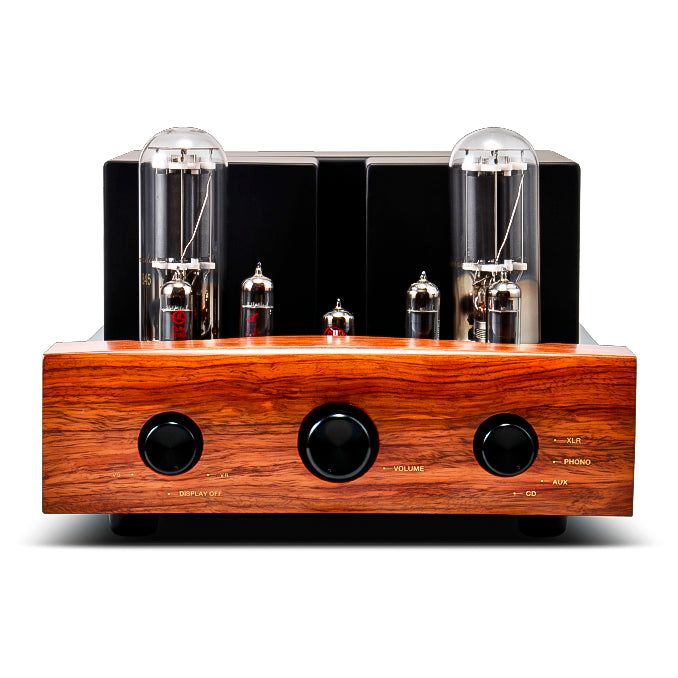Listening to music is your hobby, and some people are probably working hard on vacuum tube amplifiers as an option to enjoy higher quality music, but what is actually a vacuum tube? Vous pouvez avoir des doutes et des préoccupations quant à ce qu'il faut faire la maintenance après les ventes lors de l'utilisation. Cette fois, j'ai écrit sur l'entretien après-vente pour les tubes à vide.
Cliquez ici pour la page du produit pour les amplificateurs de tube à vide
https://www.exclusive-audio.jp/shop/products/list.php?category_id=32
Cliquez ici pour la page du produit pour l'amplificateur indiqué sur la photo.
https://www.exclusive-audio.jp/shop/products/detail.php?product_id=628
Vacuum tubes are light bulb-like components that have been used for decades before the invention of transistors and semiconductors, and are used for many years, which control audio signals and current. In addition, vacuum tubes with the same standard and compatible specifications are manufactured from various manufacturers around the world, and can be replaced with vacuum tubes from different manufacturers than those that came with the amplifier. Les matériaux, les processus de fabrication et l'environnement sont-ils utilisés même pour les tubes à vide de la même norme? Chaque fabricant a ses propres caractéristiques en son. Therefore, the great attraction of vacuum tube amplifiers is that they can enjoy pursuing the sound they like by replacing them with other manufacturers.
Regarding replacement, pre-tubes, which are responsible for adjusting the disturbed audio signals and delivering them to the power amplifier, can be easily replaced. However, for output tubes that amplify the audio signal sent from the pre-tube to increase the amount of current, they require bias adjustment to adjust the amount of current to suit the vacuum tube used. Thankfully, many amplifiers now have self-bias adjustment, eliminating the need for troublesome bias adjustments, making it possible to easily replace the same-model and compatible vacuum tubes.
Even if you have not replaced the vacuum tube, just as the bulb is a consumable product, if you use the vacuum tube for a long period of time, its function will deteriorate and you will need to replace it.
Alors, quand la durée de vie du tube à vide sera-t-elle remplacée, quand et quand sera-t-elle remplacée?
L'un des horaires est si le tube se casse pour une raison quelconque. Just like incandescent bulbs, air enters the glass tube, which is in a vacuum state, or the internal lines are broken, making it easy to understand because the amplifier is not operating properly and there is no sound. C'est plus un accident qu'une vie.
Et l'autre est une durée de vie. Les tubes à vide durent généralement assez longtemps et dureraient environ 5 000 heures. Si cela est long, il n'y a presque pas de réglementation comme quand la remplacer. In fact, many of the vacuum tubes on the market and other products from manufacturers, which are advertised as original products, are unused stock and used items manufactured decades ago, manufactured and used. Lorsqu'ils sont utilisés avec des équipements audio, il existe des chefs-d'œuvre qui peuvent produire de bons sons même après des décennies, selon la façon dont ils sont utilisés. Even so, the deterioration progresses gradually, and as it is a long life, it is likely that people continue to use it without realizing that their performance has already deteriorated.
Unlike the easily visible broken patterns where no sound is produced at all, the symptoms of life expectancy are listening to the sounds, and it's very vague, like there's a bit of noise in the sound...is the sound a little distorted? Peut-être que c'est un peu petit ... si cela semble différent de ce dont vous vous souvenez, alors doutez de la détérioration et du vieillissement des tubes à vide lol. It's a bit sloppy, but it's difficult to understand because of the familiarization and changes in the system. Pour cette raison, certains amplificateurs ont un compteur qui vous permet de vérifier l'état du tube à vide à tout moment.
Cliquez ici pour la page du produit pour l'amplificateur indiqué sur la photo.
https://www.exclusive-audio.jp/shop/products/detail.php?product_id=196
Generally, a change in the mirror surface at the top of the vacuum tube is a symptom of lifespan and deterioration that allows you to see the vacuum tube itself with your eyes. This is a material called getter that adsorbs impurities and other substances to prevent the vacuum inside the vacuum tube, which is applied to part of the back of the glass tube. En raison de l'âge et de l'utilisation continue, ces zones argentées peuvent décoller, s'estomper et l'intérieur du tube à vide peut devenir plus sombre. Si ces conditions peuvent être confirmées visuellement, c'est la norme qui peut être déterminée comme la durée de vie d'un tube à vide. Ainsi, comme guide de votre durée de vie, vérifiez régulièrement pour voir si votre Getter diminue.
Cliquez ici pour la page du produit pour l'amplificateur indiqué sur la photo.
https://www.exclusive-audio.jp/shop/products/detail.php?product_id=511
However, there is no need to be very careful about the lifespan, and as mentioned above, you can enjoy the difference in sound quality by replacing the tube with a vacuum tube of the same type or compatible model, and enjoying the difference in sound quality, while occasionally wiping the glass tube from time to time, or using an absolute ethanol or other material to carefully remove dirt when replacing it.
To put it simply, you can enjoy vacuum tube amplifiers as you feel symptoms like the bulbs you use have been using have been getting bad recently, dark, or claps, and you think you have to replace them, so even first-time users should give it a try.





























